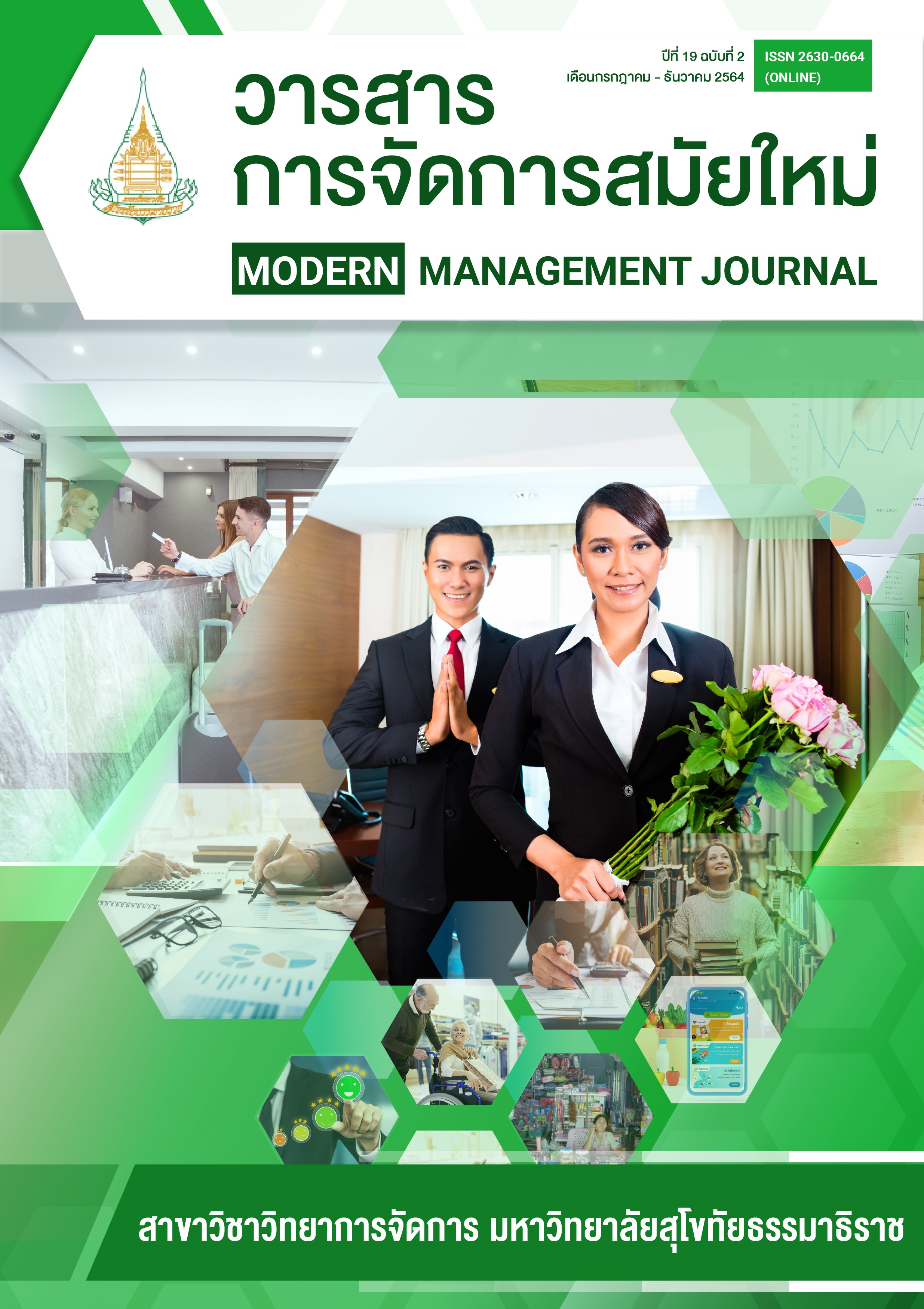Promoting Cultural Tourism in the Thai Way of Life along with Canal in Nonthaburi Province
Keywords:
Thai Cultural Tourism, Water-based Tourism, Klong Aomnon, Nonthaburi ProvinceAbstract
The purposes of this participatory action research were: 1) to study the potential of Klong Aomnon areas towards cultural tourism in the Thai way of life along with canal in Nonthaburi Province; 2) to develop the personnel competency in cultural tourism; and 3) to develop cultural tourism products/routes on the Thai way of life along with the canal. The purposive criteria was applied to determine the target population, which consisted of 1) the stakeholders of Thai cultural tourism along canal in Nonthaburi province, including community people and government representatives, and 2) tourists. The research instruments used for data collection were interviews, questionnaires, and checklists. Data analysis consists of content analysis, Descriptive statistics, and Paired t-test. The finding indicated that 1) the tourist site management to have the potential to accommodate tourists, including accessible facilities for all, was necessary to educate the community people to realize the importance of canal water resources and physical resources conservatives along the canal to maintain identity. 2) The development of personnel competency in cultural tourism along canal was to design the community spirit of service. Service providers should be developed to have the potential to serve tourists by recognizing the role of being a good host, and able to manage Thai cultural tourism effectively. 3) The Cultural Tourism Product development was defined as a designing the tourism route with cultural highlights in tourist destination. The route was emphasize on cultural tourism activities where all groups of tourists can perceive the value and participate in. In addition, communities should continuously evaluate tourists' satisfaction towards cultural tourism products.
References
Adillón, R. (2019). Diamond Model: A Theoretical Framework for the Sustainable Development of Tourism. Art Human Open Acc J. 3(1), 11‒23. DOI: 10.15406/ahoaj.2019.03.00099.
Alawi, G.M., Jamjoum, H., & Samir, H., (2018). Enhancing the Cultural Tourism Experience: The Case of Historical Old Jeddah. WIT Transactions on the Built Environment. 177, 39-50. DOI: 10.2495/IHA180041.
Australia ICOMOS. (2000). The Burra Charter: The Australia ICOMOS Charter for Places of Cultural Significance 1999, with Associated Guidelines and Code on the Ethics of Co-existence in Conserving Significant Places. Australia ICOMOS Inc. Retrived from http://australia.icomos.org/wp-content/uploads/BURRA CHARTER.pdf.
Buhalis, D. (2000). Marketing the Competitive Destination of the Future. Tourism Management. 21 (1), 97-116.
Butrngamdee, N. (2018). Tracing Nirat for Cultural Heritage Routes: A Case Study of Bang Kruai District, Nonthaburi. SDU Research Journal. 14(2), 67-83.
Chen, C.-F., & Chen, F.-S., (2010). Experience Quality, Perceived Value, Satisfaction and Behavioral Intentions for Heritage Tourists. Tourism Management. 31(1), 29–35. DOI: 10.1016/J.TOURMAN.2009.02.008
Cochran, W. G. (1963). Sampling Techniques, 2nd Ed., New York: John Wiley and Sons, Inc.
Grayson, K., & Martinee, R. (2004). Consumer Perceptions of Iconicity and Indexicality and their Influence on Assessments of Authentic Market Offerings. Journal of Consumer Research. 31(2), 296-312.
Hargrove, C. (2014). Cultural Tourism: Attracting Visitors and Their Spending. National Cultural Districts Exchange Report: Americans for the ARTS, Washington, D.C. Retrived from https://www.americansforthearts.org/
Jennings, G. (2006). Water-Based Tourism, Sport, Leisure, and Recreation Experiences. In Water-Based Tourism, Sport, Leisure, and Recreation Experiences; Jennings, G., Ed.; Butterworth-Heinemann: Oxford.
Juchooy, S. (2012). Way of Life in the Upper Bangkoknoi - Cannal Nonthaburi povince to Sufficiency Economy Concept. Research Report. Research funding from Rajapruk University.
Khemthong, S., Boonyaperm, T., & Charnkit, P., (2021). Enhancing the Quality Tourism in the Thai Way of Life along with Canal in Nonthaburi Province. Research Report. Research funding from Administration and Capital Management Unit for Enhancing the Competitiveness of The Country (AEC).
Klinmeang, J. (2015). Guidelines for Tourism Management: A Case Study of Cultural Attraction Klong Bang Luang Community Phasi Charoen, Bangkok. Master Thesis. National Institute of Development Administration.
Lau, R.W.K. (2010). Revisiting Authenticity: A Social Realist Approach. Annals of Tourism Research. 37(2), 478-498.
Lloyd-Walker, B., & Cheung. Y.P. (1998). IT to Support Service Quality Excellence in Australia Banking Industry. Managing Service Quality. 8 (11), 350-358.
Lisanan, N. (2004). Guidelines for Conservation and Rehabilitation of Amphawa Canal Communities, Samut Songkhram Province. Academic Documents Architecture...House...City. Faculty of Architecture: Khon Kaen University.
Martin, K. (2010). Living Pasts: Contested Tourism Authenticities. Annals of Tourism Research. 37(2), 537-554.
McKercher, B., & Cros, H. (2002). Cultural Tourism: The Partnership between Tourism and Cultural Heritage Management. New York: Haworth Hospitality Press.
Middleton, V. T. C., Fyall, A., Morgan, M., & Ranchhod, A. (2009). Marketing in Travel and Tourism
(4th ed.). Oxford, UK: Butterworth- Heinemann.
Nastasi, B. K., & Schensul, S. L. (2005). Contributions of Qualitative Research to the Validity of Intervention Research, Journal of School Psychology. 43(3), 177-195.
Oh, H. (2000). Diner’s Perceptions of Quality, Value and Satisfaction. Cornell Hotel and Restaurant Administration Quality. 41(3), 58–66.
Pike, S. (2008). Destination Marketing: An Integrated Marketing Communication Approach. Butterworth-Heinmann, Burlington, MA.
Prentice, R. (2001). Experiential Cultural Tourism: Museums and the Marketing of the New Romanticism of Evoked Authenticity. Museum Marketing and Curatorship. 19(1), 5-26.
Provincial Development Plan of Nonthaburi: Review version. (2020). Provincial Development Plan of Nonthaburi during period of the year 2018- 2021. Retrived from http://nonthaburi.go.th/57782.html.
Richards, G. (1996). Cultural Tourism in Europe, Wallingford, CAB International.
Srichada, T., & Chaisaengpratheep, N. (2018). Staff Training in Hospitality Sector in Order to Enhance the Service Quality. Journal of Humanities and Social Science Valaya Alongkorn. 13(1), 228-235.
Zeithaml, V. A. (1988). Consumer Perceptions of Price, Quality and Value: A Means-end Model and
Synthesis of Evidence. Journal of Marketing, 52, 2–22.
Downloads
Published
Versions
- 2022-02-01 (4)
- 2022-02-01 (3)
- 2022-02-01 (2)
- 2022-01-02 (1)
How to Cite
Issue
Section
License
Copyright (c) 2022 Modern Management Journal

This work is licensed under a Creative Commons Attribution-NonCommercial-NoDerivatives 4.0 International License.



